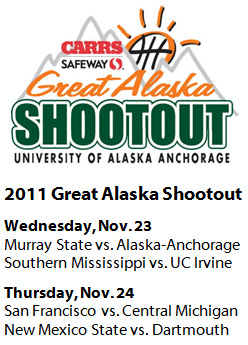
With one of the signature events of college basketball's preseason schedule teetering on the verge of extinction, the state of Alaska has intervened with a three-year reprieve.
Alaska's proposed $3.2 billion capital budget includes a three-year, $2.5 million subsidy to the Great Alaska Shootout to help it lure elite teams, big crowds and TV carriers to the floundering event once again. Gov. Sean Parnell has said he intends to trim $400 million off the proposed budget before approving it, so the appropriation must survive his vetoes for the Shootout to receive it.
 The Alaska legislature deemed the Shootout worthy of state funds because the tournament annually brings in more than $5 million to Anchorage at a time of year when the tourism industry suffers from the frigid winter weather. Alaska-Anchorage athletic director Steve Cobb intends to use the money to increase the appearance fees that attract top programs and to pay for hotel, rental car and airline vouchers that would help bring folks outside of Anchorage to the tournament.
The Alaska legislature deemed the Shootout worthy of state funds because the tournament annually brings in more than $5 million to Anchorage at a time of year when the tourism industry suffers from the frigid winter weather. Alaska-Anchorage athletic director Steve Cobb intends to use the money to increase the appearance fees that attract top programs and to pay for hotel, rental car and airline vouchers that would help bring folks outside of Anchorage to the tournament.
"The money is very important to us because quite frankly, we thought for a couple years we might not even survive," Cobb said by phone. "We're going to try to boost attendance and ticket sales by making it easier for our fellow citizens to come enjoy the event. And we're going to give people more reason to come by having a little stronger fields than we've had the past few years."
Higher-profile teams are a survival must for an event that was once as prestigious as the Preseason NIT or the Maui Invitational but has tumbled toward irrelevance the past few years.
In 2008, the Shootout's highest-profile teams were San Diego State and Portland State. In 2009, Shootout officials could only attract six teams instead of the usual eight. In 2010, St. John's and rebuilding Arizona State bolstered a mediocre field a bit. But next November's event will be another step backward with Murray State, Southern Mississippi and San Francisco highlighting a lackluster field.
Why is a tournament that previously featured a defending national champion five times now struggling to attract a single power-conference team? Blame a rule change the NCAA passed in 2006 allowing teams to play in more than two "exempt events" every four years, creating a demand for more early-season tournaments and empowering ESPN to create new events.
In the three years following that rule change, ESPN launched six preseason tournaments, from the Old Spice Classic in Orlando, to the 76 Classic in Anaheim, to the Diamond Head Classic in Honolulu. The Maui Invitational and the Preseason NIT have continued to thrive because of their prestige, prime locations and national TV deals, but other non-ESPN tournaments suffered or were forced out of the market altogether.
"ESPN and the NCAA are both thousand-pound gorillas," Cobb said. "It's very hard to compete against both of them."
The Great Alaska Shootout's steep decline became inevitable in 2007 when ESPN chose not to renew its TV contract. Not only was the Shootout unable to offer the scenic weather or lucrative appearance fee other tournaments could, its new TV deal with Fox College Sports doesn't provide teams nearly the exposure of the ESPN-run events.
Other preseason tournaments have also tweaked their formats to make themselves more attractive to top programs, expanding to 16 teams to ensure every school gets four games yet guaranteeing the four highest-profile programs spots in the semifinals. That format may not thrill fans who appreciate competition, but elite teams get an extra game or two worth of ticket and concessions revenue, smaller programs receive higher appearance fees and TV networks ensure the most desirable hand-picked matchups.
"You know something's wrong when you play a tournament game but you announce before the game who's advancing," Cobb said. "It's a money scam. We're trying to run a traditional preseason tournament and these other deals are becoming made-for-TV events."
Despite the obvious advantages other tournaments have over the Shootout, Cobb believes the money from the state will help level the playing field and keep the event "viable."
The Shootout's 2012 field is not yet set, but Cobb expects more competitive appearance fees to enable him to land two top 30 programs. Furthermore, he's confident the promise of a stronger field will help him negotiate "a stable, solid TV deal."
It remains to be seen whether Cobb can follow through on both of those statements, but it's clear he's going to do everything in his power to make it happen.
"We feel a real obligation to our state to keep this event going," Cobb said. "November's a bad month for business in Anchorage. The economic impact of our tournament is in excess of $5 million to our city. That's not a huge number but it's a significant one. My administration feels a strong responsibility as the caretakers of this tournament to keep it going and even have it prosper again."
Autumn Reeser Camilla Belle Blu Cantrell Jaime King Lokelani McMichael
No comments:
Post a Comment